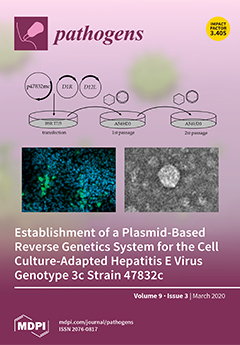Gray mold disease caused by
Botrytis cinerea is a devastating disease that leads to serious financial loss. In this study, the entomopathogenic fungus
Metarhizium anisopliae that acts against the gray mold pathogen
B. cinerea was evaluated.
M. anisopliae produced a significant inhibition zone
[...] Read more.
Gray mold disease caused by
Botrytis cinerea is a devastating disease that leads to serious financial loss. In this study, the entomopathogenic fungus
Metarhizium anisopliae that acts against the gray mold pathogen
B. cinerea was evaluated.
M. anisopliae produced a significant inhibition zone in front of the
B. cinerea colony in the dual culture test. In addition, volatile organic compounds generated by
M. anisopliae were shown to have an inhibitory effect on
B. cinerea mycelia growth and reduced 41% of gray mold severity of postharvest tomatoes. The 10% concentration of the culture filtrate of
M. anisopliae inhibited 88.62% of colony radial growth as well as 63.85% of sclerotia germination and all conidia germination of
B. cinerea. Furthermore, the culture filtrate of
M. anisopliae retained its inhibitory effect against the radial growth of
B. cinerea even after heating for 15 min at 100 °C. Feasible mechanisms of
M. anisopliae involved in the control of
B. cinerea were explored, and it was demonstrated that the plasma membrane of
B. cinerea conidia was damaged by the product of metabolism of
M. anisopliae. In addition, after treating with culture filtrate of
M. anisopliae, the
B. cinerea phenotype was shown to be abnormal, and cell organelles of
B. cinerea mycelia were damaged significantly. A significant control efficacy of
M. anisopliae against tomato gray mold was detected on both the detached leaf assay (84.24%) as well as the whole plant (72.38%). In addition, a 78% reduction in tomato fruit mold was detected at a 10% treated concentration of
M. anisopliae. These findings suggest that
M. anisopliae possesses potential as a biocontrol agent against tomato gray mold in the greenhouse and during the postharvest stage.
Full article






